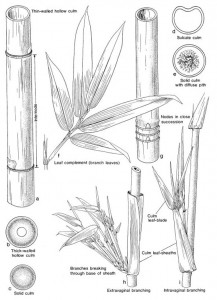 A bamboo pole is called a culm. It is the telescopic extension of the emerging shoot and grows to full height at a rapid rate that can exceed a metre a day.
A bamboo pole is called a culm. It is the telescopic extension of the emerging shoot and grows to full height at a rapid rate that can exceed a metre a day.
Perhaps the most noticeable characteristic of bamboo is the segmentation of the culm into distinct nodes or joints with intermediate smooth sectors called internodes.
In the great majority of cases the culm internodes are hollow but in all cases the nodal junction is solid allowing for the transverse distribution of nutrients and water.
The external surface is polished and extremely hard being coated with a protective screen of wax and silica.
Peripheral culm tissue is a dense matrix of elongated cellulose plant fibres cemented together by a substance called lignin to provide a strong and very flexible pole.
Poles have multitudes of uses but must be left in the grove or stand for at least 3 years before they are harvested for the timber. When harvested they are preferably stored vertically in the shade to dry. Young culms harvested and exposed to the sun will shrink and/or crack and are susceptible to borer attack.